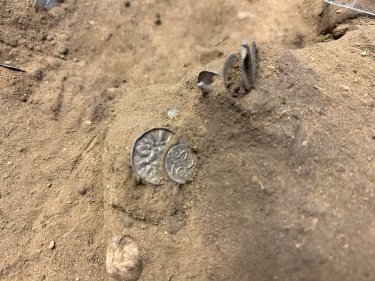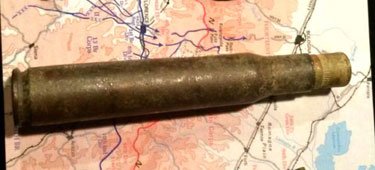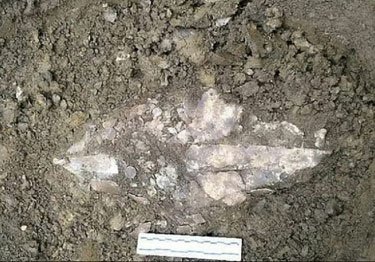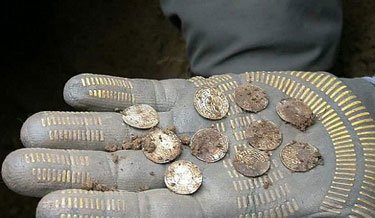Two Viking Hordes Discovered in Jutland
Buried Treasure, Denmark, Harald Bluetooth, Metal Detecting, Vikings
The History Blog reports the latest metal detecting finds.
Two hoards of Viking hacksilver and coins dating to the late 10th century have been unearthed under a cornfield near Bramslev in northern Jutland. The two treasures were discovered less than 165 feet apart and are very similar in content. They were originally even closer, but later agricultural activity disturbed the deposits, intermingling the coins and other silver objects.
The first pieces were discovered last fall by Jane Foged-Mønster, a member of a local metal detecting association, Nordjysk Detektorforening, during a rally on a farmed field. She spotted a piece of silver which turned out to be a clipped Arabic dirham coin, then another fragment, this time a decorated silver ball from a ring buckle. The group, which works closely with museum archaeologists, recognized this was a treasure find and alerted experts from the North Jutland Museum.
Archaeologists followed up quickly with a rescue excavation of the site. Because it was actively in use for agriculture, anything else that might have been part of the hoard remaining in the plow layer was at imminent risk of being scattered or even destroyed. Jane Foged-Mønster and two of her co-discoverers from the metal detecting group aided in the excavation.
The archaeological team and volunteers spent a week digging at the site. They unearthed 300 finds, from small clippings of silver to jewelry and coins. The decorated ball terminal on a silver rod that Jane Foged-Mønster found has a pair. They both weigh about 70 grams (2.5 oz) and originally were part of the same piece of jewelry, likely a very large ring brooch. This type of jewel was worn by high-status men of Viking Ireland. Something this large and heavy and ornately decorated would have belonged to someone at the highest echelons of society like a bishop or even a king. It was likely looted by Danes in a raid and cut up for its silver weight.
Among the 300 finds are 50 coins, most of them Danish, but also German and Arabic. Some of the Danish coins are extremely rare cross coins struck in the reign of Harald “Bluetooth” Blåtand in the 970s and 980s. The crosses on the coins are believed to be connected to his King Harald’s conversion to Christianity and his aim of Christianizing the Danes. The ring fort of Fyrkat, built by King Harald Bluetooth around the same time the coins were struck, is just five miles away from the hoard site.












